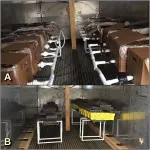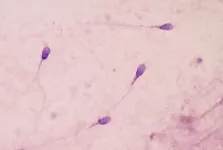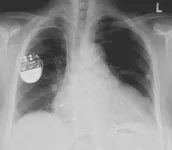Robot learns fast but safe navigation strategy
Combining deep reinforcement learning and curriculum learning to achieve fast but safe mobile robot navigation
2021-01-19
(Press-News.org) Overview:
A research group from the Active Intelligent System Laboratory (AISL) at Toyohashi University of Technology (TUT) has proposed a new framework for training mobile robots to quickly navigate while maintaining low collision rates. The framework combines deep reinforcement learning (DRL) and curriculum learning in the training process for robots to learn a fast but safe navigation policy.
Details:
One of the basic requirements of autonomous mobile robots is their navigation capability. The robot must be able to navigate from its current position to the specified target position on the map as per given coordinates, while also avoiding surrounding obstacles. In some cases, the robot is required to navigate with a speed sufficient to reach its destination as quickly as possible. However, the robots that navigate faster usually have a high risk of collision, making the navigation unsafe and endangering the robot and the surrounding environment.
To solve this problem, a research group from the Active Intelligent System Laboratory (AISL) in the Department of Computer Science and Engineering at Toyohashi University of Technology (TUT) proposed a new framework capable of balancing fast but safe robot navigation. The proposed framework enables the robot to learn a policy for fast but safe navigation in an indoor environment by utilizing deep reinforcement learning (DRL) and curriculum learning.
Chandra Kusuma Dewa, a doctoral student and the first author of the paper, explained that DRL can enable the robot to learn appropriate actions based on the current state of the environment (e.g., robot position and obstacle placements) by repeatedly trying various actions. In addition, the paper explains that the execution of the current action stops immdediately the robot achieves the goal position or collides with obstacles because the learning algorithms assume that the actions have been successfully executed by the robot, and that consequence needs to be used for improving the policy. The proposed framework can help maintain the consistency of the learning environment so that the robot can learn a better navigation policy.
In addition, Professor Jun Miura, the head of AISL at TUT, described that the framework follows a curriculum learning strategy by setting a small value of velocity for the robot at the beginning of the training episode. As the number of episodes increases, the robot's velocity is increased gradually so that the robot can gradually learn the complex task of fast but safe navigation in the training environment from the easiest level, such as the one with the slow movement, to the most difficult level, such as the one with the fast movement.
Experimental results and prospect:
Because collisions in the training phase are undesirable, the research of learning algorithms is usually conducted in a simulated environment. We simulated the indoor environment as shown below for the experiments. The proposed framework is proven to enable the robot to navigate faster with the highest success rate compared to other previously existing frameworks both in the training and in the validation process. The research group believes that the framework is valuable based on the evaluation results, and it can be widely used to train mobile robots in any field that requires fast but safe navigation.
INFORMATION:
Funding Agency:
This work was supported in part by the Japan Society for the Promotion of Science (JSPS) KAKENHI under Grant 17H01799.
Reference:
C. K. Dewa and J. Miura, "A Framework for DRL Navigation With State Transition Checking and Velocity Increment Scheduling," in IEEE Access, vol. 8, pp. 191826-191838, 2020, doi: 10.1109/ACCESS.2020.3033016.
[Attachments] See images for this press release:

ELSE PRESS RELEASES FROM THIS DATE:
2021-01-19
CHAMPAIGN, Ill. -- The fossilized insect is tiny and its genital capsule, called a pygophore, is roughly the length of a grain of rice. It is remarkable, scientists say, because the bug's physical characteristics - from the bold banding pattern on its legs to the internal features of its genitalia - are clearly visible and well-preserved. Recovered from the Green River Formation in present-day Colorado, the fossil represents a new genus and species of predatory insects known as assassin bugs.
The find is reported in the journal Papers in Palaeontology.
Discovered in 2006 by breaking open ...
2021-01-19
Simple vision tests can predict which people with Parkinson's disease will develop cognitive impairment and possible dementia 18 months later, according to a new study by UCL researchers.
The study, published in Movement Disorders, adds to evidence that vision changes precede the cognitive decline that occurs in many, but not all, people with Parkinson's.
In another new study published today in Communications Biology, the same research team found that structural and functional connections of brain regions become decoupled throughout the entire brain in people with Parkinson's disease, particularly among people with vision problems.
The ...
2021-01-19
There are high hopes for the next generation of high energy-density lithium metal batteries, but before they can be used in our vehicles, there are crucial problems to solve. An international research team led by Chalmers University of Technology, Sweden, has now developed concrete guidelines for how the batteries should be charged and operated, maximising efficiency while minimising the risk of short circuits.
Lithium metal batteries are one of several promising concepts that could eventually replace the lithium-ion batteries which are currently widely used - particularly in various types of electric vehicles.
The big advantage of this new battery type is that the energy density can be significantly ...
2021-01-19
New research suggests a unique program called Moms2B at The Ohio State University Wexner Medical Center shows a reduction in adverse pregnancy outcomes in communities disproportionately affected by these public health issues.
The study, led by researchers Courtney Lynch and Erinn Hade and published in the Journal of Maternal and Child Health, indicates that women who attended at least two Moms2B sessions may have lower rates of preterm birth, low birth weight and infant mortality compared to women who only received individual care.
"When we started the program 10 years ago, ...
2021-01-19
New study identifies a bizarre new species suggesting that giant marine lizards thrived before the asteroid wiped them out 66 million years ago.
A new species of mosasaur - an ancient sea-going lizard from the age of dinosaurs - has been found with shark-like teeth that gave it a deadly slicing bite.
Xenodens calminechari, from the Cretaceous of Morocco, had knifelike teeth that were packed edge to edge to make a serrated blade and resemble those of certain sharks. The cutting teeth let the small, agile mosasaur, about the size of a small porpoise, punch above its weight, cutting fish in half and taking large bites from bigger animals.
Dr Nick Longrich, Senior Lecturer at the Milner Centre for Evolution at the University of Bath and lead author on ...
2021-01-19
Clumsy kids can be as aerobically fit as their peers with better motor skills, a new Finnish study shows. The results are based on research conducted at the Faculty of Sport and Health Sciences of the University of Jyväskylä and the Institute of Biomedicine of the University of Eastern Finland, and they were published in Translational Sports Medicine.
Aerobic fitness doesn't go hand in hand with motor skills
According to the general perception, fit kids also have good motor skills, while low aerobic fitness has been thought to be a link ...
2021-01-19
A group of international scientists, including an Australian astrophysicist, has used knowhow from gravitational wave astronomy (used to find black holes in space) to study ancient marine fossils as a predictor of climate change.
The research, published in the journal Climate of the Past, is a unique collaboration between palaeontologists, astrophysicists and mathematicians - to improve the accuracy of a palaeo-thermometer, which can use fossil evidence of climate change to predict what is likely to happen to the Earth in coming decades.
Professor Ilya Mandel, from the ARC Centre of Excellence in Gravitational Wave Discovery (OzGrav), and colleagues, studied biomarkers left behind by tiny single-cell organisms called archaea in the distant past, including the Cretaceous period ...
2021-01-19
In the strawberry nursery industry, a nursery's reputation relies on their ability to produce disease- and insect-free plants. The best way to produce clean plants is to start with clean planting stock. Many nurseries struggle with angular leaf spot of strawberry, a serious disease that can result in severe losses either by directly damaging the plant or indirectly through a violation of quarantine standards within the industry.
Angular leaf spot is caused by the bacterial pathogen Xanthomonas fragariae. Current management strategies rely primarily ...
2021-01-19
Chemotherapy and radiation treatments are known to cause harsh side effects that patients can see or feel throughout their bodies. Yet there are additional, unseen and often undiscussed consequences of these important therapies: the impacts on their future pregnancies and hopes for healthy children.
Extensive evidence shows that chemotherapy and radiation treatments are genotoxic, meaning they can mutate the DNA and damage chromosomes in patients' cancerous and noncancerous cells alike. When this occurs in a germline cell - which are egg cells in women and sperm in men - it can lead to serious fetal and birth ...
2021-01-19
A new type of ultra-efficient, nano-thin material could advance self-powered electronics, wearable technologies and even deliver pacemakers powered by heart beats.
The flexible and printable piezoelectric material, which can convert mechanical pressure into electrical energy, has been developed by an Australian research team led by RMIT University.
It is 100,000 times thinner than a human hair and 800% more efficient than other piezoelectrics based on similar non-toxic materials.
Importantly, researchers say it can be easily fabricated through a cost-effective and commercially scalable method, using ...
LAST 30 PRESS RELEASES:
[Press-News.org] Robot learns fast but safe navigation strategy
Combining deep reinforcement learning and curriculum learning to achieve fast but safe mobile robot navigation

